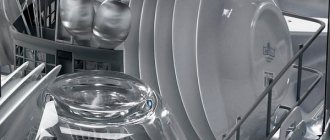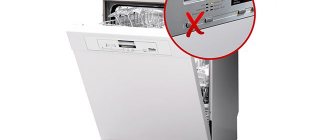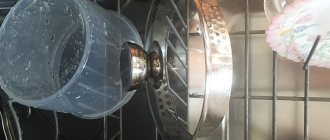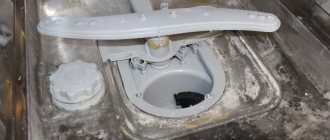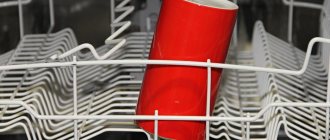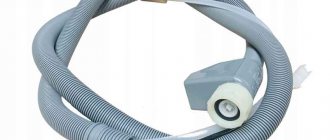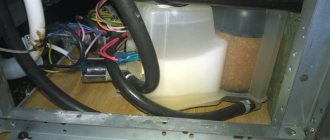Calculate cost Reviews Geography Contacts
BOSCH service center No. 1 in Moscow Post-warranty service and repair of BOSCH with home visits seven days a week from 9:00 to 22:00
8 Call back
A malfunction in which the BOSCH dishwasher does not turn off manifests itself in different ways. In some cases, after pressing the button, the machine does not allow you to select a mode and does not start the wash, while leaving the door locked and the backlight working. In others, the machine actively washes the dishes, water is poured in and drained, but the process continues endlessly.
Before looking for a breakdown, make sure that the buttons are not stuck and the mode has not been changed. In some cases, the machine takes longer to wash dishes than usual, which bothers its owner. If the mode is normal, but the BOSCH dishwasher does not turn off, and you can only stop it by unplugging the cord from the outlet, the problem may be:
- in a faulty pump;
- in control unit errors.
As a result, in the first case, the pump continues to work - pumping water through the machine, in the second - a system failure occurs, due to which the equipment “freezes”, stops washing, or repeats the same cycle endlessly.
Filter problem
If you do not wash the filter in time and food remains are stuck in the machine, the pump may not be able to cope with the task of pumping out water, thereby causing a breakdown. The same situation can arise if the plastic structure of the filter breaks.
This problem will be solved by simply cleaning the filter and possibly replacing it (in the event of a structural failure).
Clogged and broken filter
Another reason why the dishwasher drain pump does not turn off is a clogged filter. With such a problem, waste water simply cannot go down the drain and will constantly return to the bunker. In addition, mechanical damage to the filter can also lead to continuous operation of the equipment, if present, it must be replaced.
Internal faults
If all of the above faults are excluded, most likely the problem lies inside the machine. In this case, to determine the malfunction and eliminate it, it is necessary to carry out a number of actions:
- Turn off power and water supply.
- Dismantle the dishwasher. Typically, this requires removing the fixing bolts.
- Check the timer, heater and thermostat for electrical continuity. It is possible that one of the parts has failed and needs to be replaced.
- Check the programmer. The machine may not turn off if the programmer is faulty. In most cases, it cannot be repaired and must be replaced.
- Inspect the motor and pump for blockages. If it is detected, it is necessary to clean it.
- Check the pump for wear. If your dishwasher doesn't pump water out well, there's a good chance that the pump doesn't have enough power to operate properly. Don't wait until it completely fails. It is necessary to replace the pump as soon as possible.
- Check the motor for damage.
- Inspect the drive belt for damage or signs of wear. If the dishwasher has been in use for a long time, the belt may have stretched or become unusable.
If, after carrying out all the above-described manipulations, the breakdown has not been identified, you must contact the service center. Specialists will be able to quickly identify the cause of the malfunction and eliminate it.
How to Reset a Dishwasher
A couple of decades ago, dishwashers were the privilege of only wealthy citizens of our country, as well as movie characters. Very little time passed, and this unit appeared in the homes of ordinary people.
Equipment manufacturers were able to fine-tune the technology for manufacturing dishwashers so that they are not expensive and allow housewives to save time, energy and labor. Like any other equipment, as its service life increases, dishwashers begin to malfunction and accumulate errors, such as E03, E4, E22, E24, E09 and many others. Many of the software errors block the operation of the equipment and prevent it from being used for its intended purpose. At such a moment, housewives and owners are faced with the question of how to reload the dishwasher quickly and without consequences.
Like any other appliance, as its service life increases, dishwashers begin to malfunction and accumulate errors.
Triggering of the Aquastop protective system
Dishwashers from Miele, NEFF, SMEG and other modern brands are often repaired because the leakage protection is triggered (error code E15). A special system, which is a float sensor, is located at the bottom of the device and is triggered at the slightest amount of water entering the pan (instantly drains the liquid into the sewer). If the leak is constant, the machine simply will not be able to work properly - the sponge located in the inlet hose will swell and block access to the flow. To bring it back to life, it is necessary to find and repair all leaks, as well as install a new filler tube.
Pressostat clogged
Why won't my dishwasher turn off and the pump run? Another reason for this phenomenon is considered to be a clogged pressure level sensor, due to which it shows unreliable data. The pressure switch itself is a round part equipped with a membrane, contacts and a narrow tube connecting the relay to the PMM tank. This hose accurately monitors pressure changes in the chamber and measures the amount of fluid, so if it becomes clogged with debris, the signals will become inaccurate. To fix the problem, remove the plastic box located near the circulation pump, disassemble the pressure switch and rinse the tube under high water pressure.
If you have done everything possible, but the dishwasher still does not turn off, contact a qualified technician who can repair dishwashers from Siemens, Electrolux, Bosch and other well-known brands. This will be much faster and more reliable than continuing to search on your own.
Why a household appliance may not turn on
Here are some of the most common reasons for this phenomenon.
The power cord or outlet is faulty.
Yes, perhaps the source of the problem does not lie in the deep depths of the device, but is located literally on its surface. That is, the culprit of the problem is a broken power cord or a malfunctioning socket. If you are comfortable with electricity, you will be able to identify and fix the problem yourself. Otherwise, call an electrician for help.
Capacitor failure.
Unfavorable operating conditions for equipment and periodic power surges can lead to failure of such an important device as a capacitor. You can verify the damage yourself. To do this, you need to disassemble the dishwasher and find the possible source of its problem. You should act according to the following algorithm:
- Remove the front panel, which is located directly under the dishwasher door, and then the side fastenings of the tray. Please note that to prevent the formation of wet spots around the repair site, the floor should first be covered with floor rags.
- Open the machine door, remove the filter and remove the impeller.
- Close the door, carefully turn the dishwasher upside down and remove the tray, simultaneously disconnecting the hoses and wires.
- Find the capacitor (it is located on the circulation pump) and use a multimeter to measure the resistance on it.
- If it fails, replace it with an original analogue.
If you find that the capacitor is working, immediately carry out a visual check for burnt or frayed wires. Perhaps it's them.
Problems with the electrical and control unit.
If you still cannot find out the reasons for the dishwasher not turning on, then perhaps they relate to electrical problems or malfunctions in its control module. It is not recommended to try to figure them out on your own. Unless, of course, you plan to purchase a new dishwasher in the near future.
Spontaneous shutdown
The dishwasher may turn off for the following reasons:
- Wrong washing mode set.
- There is no power supply. You need to check the switchboard, perhaps the fuse has blown or the circuit breaker has switched off.
- The fuse in the plug has blown. It is necessary to replace it and check the entire safety device.
- The main pump is clogged. This problem is difficult to debug with your own hands, but you can check the exhaust port. You need to lift the filter and inspect for blockages.
- Problems with the thermostat.
- The heating element has failed.
- The programmer is broken.
- Water does not flow into the working chamber. This may be due to the tap being closed.
The float switch often breaks
. It is a mechanism in the form of a plastic float located in the floor of the machine. When the chamber is full, it floats up. This switch can block the operation of the dishwasher if its valves are faulty.
The inlet port may have failed
located on the bottom of the device. It may become clogged and block the passage of water.
The pressure switch may break
. It needs to be disconnected from the terminals and blown into the pipe to which the plastic tube is adjacent.
If a shutdown occurs when you first start the machine, then the wires in the plug itself may be incorrectly connected.
Failures in the electromagnetic control coil are also common. The breakdown is very serious and will require the intervention of specialists.
the sprayer may fail
.
A burnt out motor or problems with a pump require calling in a professional.
The electric heating element may burn out during the drying phase.
or the fan will malfunction and the machine will turn off spontaneously.
Electric pump failure
What to do if the dishwasher does not turn off, and not one of the above methods did not give the desired effect? In this case, you should diagnose the electrical unit responsible for the operation of all equipment. This is done according to the following scheme:
- Unplug the dishwasher cord from the outlet.
- Close the inlet valve.
- Disable all programs.
- Turn the dishwasher cabinet on its side.
- Twist the assembly and remove it from its place.
- Disassemble and carefully inspect all parts. If the pump shows any signs of wear, it is better to replace it.
- Unscrew the bolts that hold the bottom.
- Unscrew the clamps on the pipe and disconnect it from the pump.
The pump does not turn off
The dishwasher pump is designed to pump waste water out of the washing tank. During the entire washing cycle, dirty water can be removed repeatedly, while the program algorithm specifies at what point the control unit should give the command to turn the pump on and off, as well as the duration of operation of the drain pump.
It is very important at what moment the command to turn on the pump is given. The control unit must collect information from all sensors and, based on this information, make a decision to turn on the pump or not. If the pump runs continuously and does not turn off, this means that:
- the electrics or electronic module are faulty - commands are not given to the pump or they do not reach the pump;
- the control module receives information from the pressure switch about excess water in the Bosch dishwasher;
- the machine is not installed level (some models of dishwashers are sensitive to slopes and do not want to work normally even at a slope of 50);
- the Bosch dishwasher is not connected to the sewer correctly, which leads to a “siphon effect” (backflow of dirty water into the machine), while the pump is forced to constantly try to pump out the water;
- the pump itself is faulty.
There are also optional reasons for the constant operation of the pump, for example, in the event of a leak in the inlet hose or pipe. But in such a situation, it is quite difficult not to understand why the drain pump works strangely, because water will flow from under the car, and it will flow heavily.
An Aquastop hose for a dishwasher can prevent this from happening, but then the pump won’t work either. Even if your dishwasher does not have Aquastop protection at all, a slight leak in the hose will not affect the operation of the pump in any way; in order for the drain pump to react, a strong pressure drop is required, which can cause either a water hammer or a rupture of the hose or pipe.
For your information! Full Aquastop protection will protect the dishwasher from leaks of any nature, but you still need to be careful.
The symptom of a breakdown boils down to a constant hum emitted by the pump, regardless of whether the washing program is running or not. Moreover, if you turn off the power to the dishwasher (by unplugging the power cord), then when you turn it back on, the pump will still continue to operate continuously.
The procedure for eliminating the breakdown will depend on its nature, let's start with a simple reason: when a Bosch dishwasher is incorrectly connected to the sewer pipe, what do we do?
- Unscrew the drain hose from the siphon or sewer pipe.
- We check that the length of the hose does not exceed 2 m.
- We check the bend and height of the hose connection (the height of the connection point from the floor should be no more than 50 cm).
- We redo the connection to the sewer and screw the hose back on.
After this, the pump should stop being capricious and start working normally. If, after fixing the connection to the sewer, the Bosch dishwasher continues to use the pump excessively, you can look at how this machine is installed on the floor. Bosch brand dishwashers are not too demanding on the surface on which they are installed; even large slopes of 8-100 are allowed. Electrolux brand machines are more capricious, so they need to be installed level on a hard, reliable surface.
If the dishwasher is installed well, then most likely the problem has arisen with one of the units, the sensor, or the control module in general, which in itself is not very good. Mentally, you need to prepare for the costs and start checking the electrics and electronics of the car.
By the way, you don’t have to do it yourself; if serious problems arise with the dishwasher’s electronics, it’s better to contact a specialist. This way there is less chance of causing further damage to the dishwasher. But if you are determined to see it through to the end, at least read the advice of professionals.
The washing program does not start and does not turn off
If a Bosch dishwasher (or another) does not respond to user actions after being turned on, that is, most of the buttons do not work and it is impossible to turn on any washing program, and it is also impossible to turn off the machine from the button - this indicates a malfunction of the control panel. More precisely, a problem arose with one of the control triacs or the contacts of one of the buttons. If several buttons do not work at once, then most likely the problem is the triac.
For your information! A triac is a special semiconductor part that is installed on the control board of a Bosch (and other brand) dishwasher. Another name is symmetrical triode thyristor.
To check and replace a triac, you will need minimal knowledge of semiconductor circuits and the ability to work with a soldering iron and a multimeter. First, let's set up the multimeter.
- Turn on the device and set it to voltmeter mode.
- Set the minimum value in Volts.
- We connect the multimeter probes to each other and check how the device works; if everything is fine, we move on to the next step.
Now our task is to get to the control board. Turn off the power to the dishwasher and open its door. There are small fasteners at the ends of the door and on the inside; they need to be unscrewed while holding the door in the open position. The inside of the door will come off like a sandwich, revealing the control board. Next we do the following.
- We find triacs on the control board (see photo) and check them one by one using a multimeter.
- If you find a faulty part, carefully unsolder it and remove it.
- Take the broken part as a sample and purchase a similar one in the store or take it from a non-working device.
Important! It is necessary that the numbers and markings on the faulty part and the new one match.
- Very carefully, so as not to damage the tracks, solder the new part in place of the old one.
Now we put the control board in place, assemble the door, connect power to the dishwasher and check the operation. After these simple manipulations, the dishwasher should turn on and off normally.



